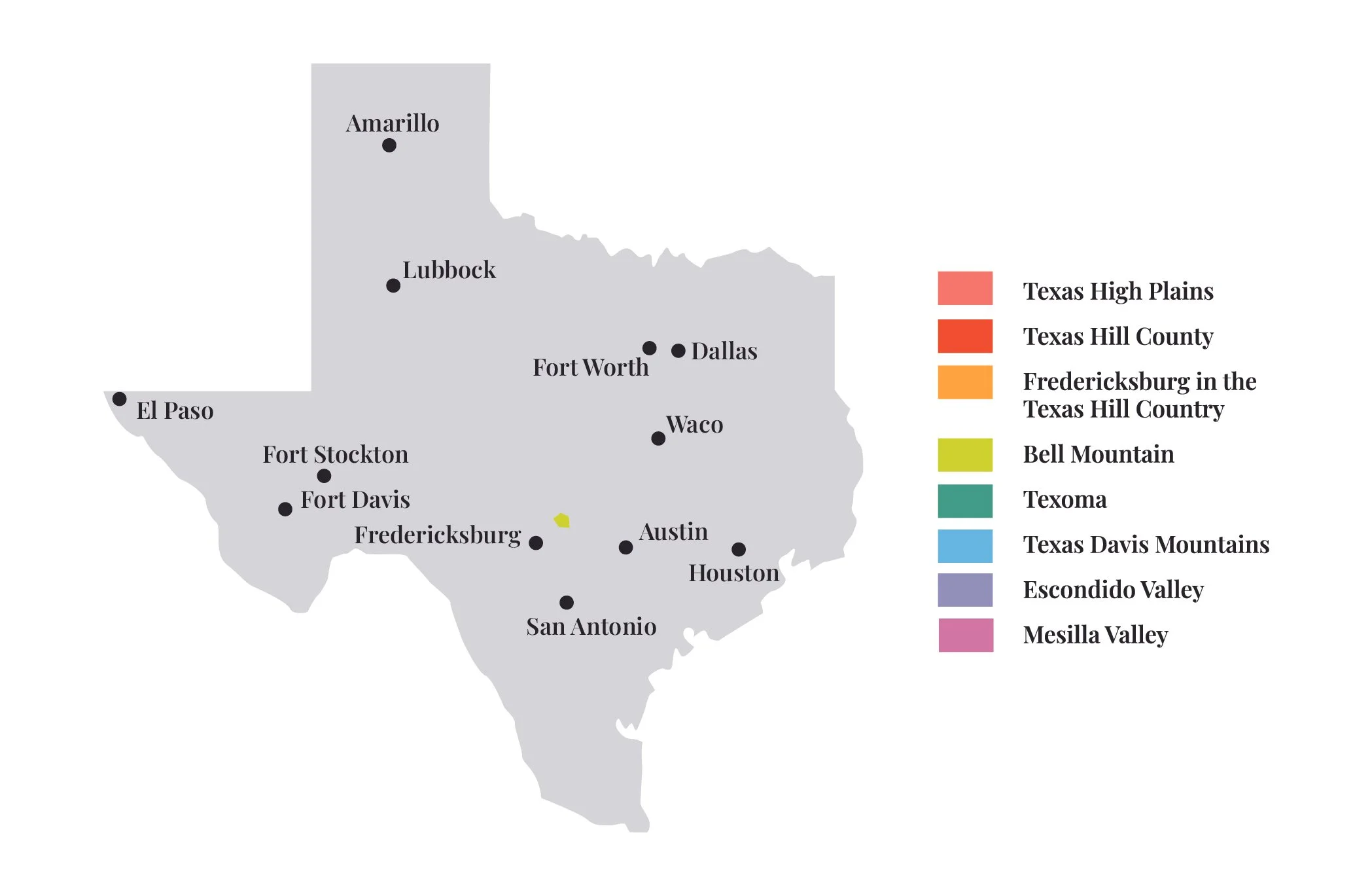Bell Mountain AVA
Texas’ First Official Wine Region
Designated in 1986, Bell Mountain American Viticultural Area (AVA) holds the distinction of being the very first federally recognized wine appellation in Texas. Nestled 15 miles north of Fredericksburg in Gillespie County, this compact 3,200‑acre region sits on pink granite slopes that rise above the Pedernales River valley. For beginning wine students, Bell Mountain offers a living laboratory where you can taste how granite soils, hilltop breezes, and Central‑Texas sunshine craft wines ranging from crisp whites to robust Rhône‑style reds.
Location & Landscape
Bell Mountain AVA lies entirely within the much larger Texas Hill Country AVA but maintains its own distinct identity. Vineyards wrap around Bell Mountain’s southeast and southwest flanks at elevations between 1,600 and 2,100 feet—high enough to earn cooler nights than the surrounding plains. The terrain is rugged: slopes of 10–15 percent force vines to dig through decomposed granite and quartz‑rich sands, yielding small, intensely flavored berries.
Climate: Warm Days, Breezy Nights
· Rainfall: 28–32 inches annually, mostly in spring and early summer thunderstorms.
· Temperature: Summer highs reach the low 90s °F, but hilltop sites cool rapidly after sunset—a 20 °F diurnal swing that preserves acidity.
· Breezes: South‑southeast winds funnel up the Pedernales valley each afternoon, reducing humidity and drying clusters after rain.
· Frost Risk: Elevation lessens but does not eliminate spring frost; wind machines and row fans provide insurance.
Bell Mountain’s moderate elevation and constant airflow help balance Texas heat, allowing both white and red varieties to thrive.
Terroir: Granite & Quartz Sands
Soils derive from Precambrian granite, gneiss, and schist that crumble into coarse, pinkish sands. These well‑drained soils force roots deep, concentrating flavors and naturally controlling vine vigor. Granite also reflects heat during the day and radiates it at night, aiding even ripening. High mineral content contributes a subtle stony note—think wet granite or river rock—commonly found in Bell Mountain Riesling and Viognier.
Signature Grapes & Why They Thrive
Cabernet Sauvignon - Granite slopes keep clusters small; warm days ripen tannins, cool nights lock in structure.
Syrah - Rhône native loves granite; elevation tempers the sun, yielding peppery aromatics.
Tempranillo - Early budbreak but thick skins handle summer storms; diurnal swing protects acidity.
Viognier - Needs heat for apricot aromatics; breezes and well‑drained soils prevent rot.
Riesling - Granite plus nighttime cooling mimic Alsace; produces lime‑peel, petrol‑tinged whites.
Tannat & Mourvèdre - Late‑ripening grapes that flourish in long, dry Texas autumns.
Growers experiment with over 30 varieties, but wine educators spotlight Rhône, Iberian, and select aromatic whites as most site‑appropriate.
Interesting Facts
· First Texas AVA: Bell Mountain earned AVA status five years before Texas Hill Country.
· Tiny but Mighty: Fewer than 70 planted acres produce boutique wines highly sought by tasting‑room visitors.
· Pedernales Falls Influence: Cool air flowing down from nearby Pedernales Falls State Park moderates evening temperatures even in August.
· German Heritage: Early settlers experimented with grape growing alongside peaches—still a hallmark crop in Gillespie County.
Visiting & Nearby Cities
• Fredericksburg – 15 miles south; hub for lodging, German cuisine, and the National Museum of the Pacific War
• Austin – 70 miles east (≈ 1 hour 15 minutes)
• San Antonio – 75 miles southeast (≈ 1 hour 20 minutes)
Tasting itineraries often pair Bell Mountain stops with neighboring Highway 290 wineries for a full‑day tour.
Putting It All Together
Bell Mountain proves that size isn’t everything in wine. Within just a few square miles, granite soils, elevation, and breezes craft distinctive wines that stand apart from broader Hill Country bottlings. It’s a case study in how micro‑terroir shapes flavor—even inside a larger AVA.
· Granite gives grip and minerality—taste a Bell Mountain Riesling next to one from limestone and note the difference.
· Elevation + breeze = balanced Texas reds—Syrah and Tempranillo gain spice and acidity absent in hotter valley floors.
Next time you encounter a Bell Mountain Syrah with violet, pepper, and granite dust notes, remember the pink hillsides north of Fredericksburg that sculpted that character.
